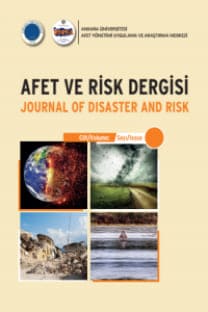Otomatik ve Manuel Kar-Su Eşdeğeri Ölçümlerinin Karşılaştırılması; Ilgaz Dağı Örneği
Kar-Su Eşdeğeri, Kar Numune Tüpü, CS725, Kar-Su Eşdeğeri Sensörü
Comparison of Automatic and Manual Snow-Water Equivalent Measurements; Mount Ilgaz Case Study
___
- Appel, F., Koch, F., Rösel, A., Klug, P., Henkel, P., Lamm, M., ve Bach, H. (2019). Advances in snow hydrology using a combined approach of GNSS in situ stations, hydrological modelling and earth observation—a case study in Canada. Geosciences, 9(1), 44. DOI: https://doi.org/10.3390/geosciences9010044
- Boike, J., Westermann, S., Gallet, J. C., Jentzsch, K., Cable, B., Bornemann, N., ve Lange, S., (2020). Near real-time observations of snow water equivalent for SIOS on Svalbard-SWESOS. SIOS., Polar Night Week, Svalbard Science Centre, Longyerbyen, 13-17 January 2020.
- Choquette, Y., Ducharme, P., ve Rogoza, J., (2013). CS725, An accurate sensor for the snow water equivalent and soil moisture measurements. In Proceedings of the International Snow Science Workshop, Grenoble, France (pp. 7-11).
- Ducharme, P., Houdayer, A., Choquette, Y., Kapfer, B., ve Martin, J. P. (2015). Numerical simulation of terrestrial radiation over a snow cover. Journal of Atmospheric and Oceanic Technology, 32(8), 1478-1485. DOI: https://doi.org/10.1175/JTECH-D-14-00100.1
- Gençer, M., Uğurlu, A., Kacar, M., Özcan, H., Kesim A. ve Aydın B., (2005). Hidrometeoroloji. T.C. Tarım ve Orman Bakanlığı, Meteoroloji Genel Müdürlüğü Yayınları, s:18, Ankara.
- Kirkham J.D., Koch I., Saloranta T.M., Litt M., Stigter E.E., Møen K., Thapa A., Melvold K. ve Immerzeel W.W. (2019). Near real- time measurement of snow water equivalent in the Nepal Himalayas, Front. Earth Sci., 7:177. DOI: https://doi.org/10.3389/feart.2019.00177
- Leppänen, L., Kontu, A., ve Pulliainen, J. (2018). Automated measurements of snow on the ground in Sodankylä. Geophysica, 53(1), 45-64.
- MGM (Meteoroloji Genel Müdürlüğü),(2020), 2019 Yılı İklim değerlendirmesi Araştırma Dairesi Başkanlığı yayını, T.C. Tarım ve Orman Bakanlığı, Meteoroloji Genel Müdürlüğü Ankara. s:10.
- Smith, C. D., Kontu, A., Laffin, R., ve Pomeroy, J. (2017), An assessment of two automated snow water equivalent instruments during the WMO solid precipitation intercomparison experiment. The Cryosphere, 11, 101-116. DOI: https://doi.org/10.5194/tc-11-101-2017
- URL 1, Campbell, (2020), https://www.campbellsci.com/cs725 [Son erişim: 15 Haziran 2020].
- URL 2, TUİK, (2020), http://tuik.gov.tr/PreTablo.do?alt_id=1027# [Son erişim: 15 Haziran 2020].
- Wright, M., (2011), Performance analysis of CS725 snow water equivalent sensor, Edmonton, AB: Campbell Scientific Corp.
- Yao, H., Field, T., McConnell, C., Beaton, A., ve James, A. L. (2018). Comparison of five snow water equivalent estimation methods across categories. Hydrological Processes, 32(12), 1894-1908. DOI: https://doi.org/10.1002/hyp.13129
- Yayın Aralığı: Yılda 4 Sayı
- Başlangıç: 2018
- Yayıncı: Ankara Üniversitesi
Biyolojik Afetler: 2021'in İlk Çeyreğinde Covid-19 Pandemisine Genel Bir Bakış
Yakup ARTİK, Nevra CESUR, Levent KENAR, Mesut ORTATATLI
Yetişkinlerin Yaşamsal Hafızaları ve Afet Bilinçleri
Covid-19 Salgınında Hastane Uygulamaları- Özel Hastane Örneği
Yenidoğan Bebek Transport Ambulansı Risk Analizi: HTEA Yöntemi ile Bir Uygulama
Afet Yönetim Sisteminin İncelenmesinde Gönüllülük Hizmetleri ve Bazı Sivil Toplum Kuruluşları
Türkiye’deki Suriyeli Göçmen Nüfus İçin Yaşam Alanı Seçimi
Gonca ÇETİNKAYA EROĞLU, Nehir VAROL
Analysis of Fire Safety Measures in Residential Buildings in Yaba LCDA, Lagos State, Nigeria
Adebola DARAMOLA, Lateef IBRAHİM
Tarihi Yapıdan Dönüştürülen Çankırı Müzesi Binasının (Türkiye) Afet Hazırlıklılığı
Kendi Kendine Yardım Temelli Çevrimiçi Psikososyal Destek Platformunun Geliştirilmesi
